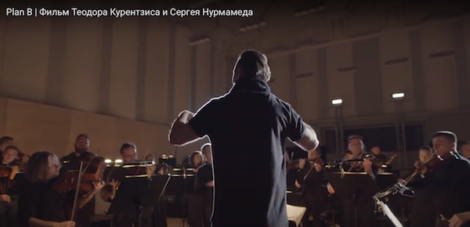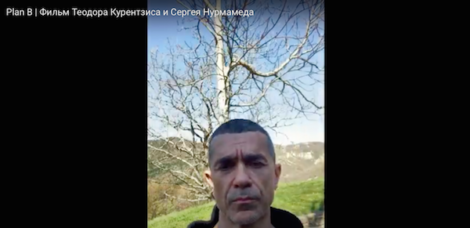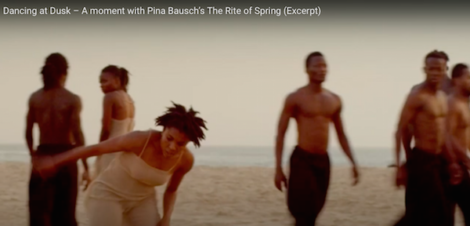Waiting for Currentzis
Review by Asada Akira
My live experience of Teodor Currentzis and musicAeterna was at the Osaka Festival Hall on February 14, 2019.
The program on that occasion consisted of Tchaikovsky’s Violin Concerto (solo by Patricia Kopatchinskaja), and Symphony No. 6 “Pathétique,” the kind of thing that, as someone who loathes the excessively emotional music of Tchaikovsky, I would usually go out of my way to avoid. But Currentzis’ Tchaikovsky with Kopatchinskaja, included on a CD I’d obtained in order to listen to Stravinsky’s Les Noces (The Wedding) conducted by him, was unexpectedly interesting. The latest generation of musicians seem to succeed in trimming the excess flab even from Tchaikovsky to give his music a totally new lease of life, thanks to orchestras that include period instruments and have a sharper sound (in stark contrast to the voluptuous caramel tones of conductors like Ormandy and Karajan), and crisper, faster tempos. Which is what made me belatedly decide to take a listen. I was not disappointed: that performance in Osaka took the power of this new generation to yet another level. Apart from instruments like the cello, most members of musicAeterna play standing up. Kopatchinskaja was even in bare feet. The sight of an entire orchestra swaying bodily while they performed, as if under Currentzis’ hypnotic control, was indeed odd, but the undeniably convincing music that emerged, had the audience in its thrall.

Teodor Currentzis
Following this memorable and inimitably live experience, when I heard that Currentzis and musicAeterna were to perform Beethoven’s Ninth at the Kyoto Concert Hall on April 10 this year to mark 250 years since the composer’s birth, I didn’t hesitate to book a seat, despite this too being a piece I would not normally bother listening to live. Due to the abrupt and unexpected arrival of COVID-19 however, the orchestra’s tour of Korea and Japan, including that concert, was canceled. Delivered up instead of this “Plan A” was the video “Plan B” presented here, newly translated into Japanese.
As well as footage of the orchestra rehearsing Beethoven, the video features various creatives including directors, composers and artists offering their lockdown thoughts. Most memorable perhaps for me, as an inherently lazy, lover of dolce far niente (sweet idleness), was Romeo Castellucci, who readily accepted this time doing nothing, but overall “Plan B” was fascinating as a document of an exceptional time “in suspension.”

Romeo Castellucci
On an added note, although the concert tour may have been canceled, a recording of Beethoven’s Symphony No. 5 “Schicksals-Sinfonie” aka “the Fate Symphony” was released in April. This too is a sharp, fresh rendering that revives in new form a familiar classic among classics, heard countless times over the years, making it an appropriate choice for the composer’s 250th anniversary. I highly recommend giving it a listen—at least until we can hear it live.
Supplementary note
It was actually Ryuichi Sakamoto who first alerted me to this video, but allow me here to mention also another one he told me about.
A project was underway involving thirty-eight dancers from fourteen African countries dancing Pina Bausch’s choreography of Stravinsky’s Rite of Spring, with performances scheduled initially in the Senegalese capital of Dakar, then around Europe, but when this tour was canceled due to COVID-19, the last dress rehearsal was filmed by the sea in Senegal, and posted on the website of Sadler’s Wells in London from July 1–31 under the title Dancing at Dusk (two short video clips are still available on the site).

Dancing at Dusk — A moment with Pina Bausch’s The Rite of Spring
Having watched, many times, Tanztheater Wuppertal’s performance of Rite of Spring directed by the now-deceased Bausch, I would hardly consider the dancing in Dakar as technically sophisticated. What this performance does convey though is the raw, unadulterated joy, and fear, of dancing together, in fact of living together. And the setting, a beach at sundown, is simply brilliant. Pina Bausch had her company dancing on red earth piled on the stage, but this stage is a real beach. Mingled with the powerful, reverberating strains of Stravinsky are the voices of people and sound of the wind. And of course there is the sun, quietly going down. As a record of the performing arts just before pandemic lockdowns brought down the curtain on actual stages, this Rite of Spring at dusk would have to be one of the most impressive. Apparently the tour has been rescheduled for 2021, but I’d love to see this video re-released, even after that.
Pina Bausch was in fact such a dominant presence that after her death, some were pessimistic about the subsequent direction of Tanztheater Wuppertal. However as can be seen for example in the documentary Dancing Dreams (Tanzträume), a project to have elderly people, children and so on dance her steps that started while Bausch was still alive, has been even more successful than anticipated. When one sees similar results emerging in Africa too (veteran performer Josephine [Jo] Ann Endicott, who was teaching children in Dancing Dreams (Tanzträume) now instructing African dancers), I feel that rather than lamenting the absence of Pina Bausch, we should be grateful that part of her legacy has come to fruition in such a wonderful way, and wait patiently for the opportunity, when the end of lockdown dawns, to actually experience her choreography in person.
One last thing: prior to hearing Currentzis, I found myself—unusually—moved by Tchaikovsky, in this case his Symphony No. 6 “Pathétique” and piano concerto in Pina Bausch’s masterpieces Viktor and Palermo Palermo. The scene in which a woman with an icy smile transcending any human emotion silently emerges in accordance with the “pathetique” theme at the start of the symphony’s finale, and the scene in which six dilapidated pianos lined up on stage perform the theme at the beginning of that famous concerto, feel as powerful to me now, as when I first encountered them.
Akira Asada
Critic / Director, ICA Kyoto
(Publication of the English version: October 30, 2020)



